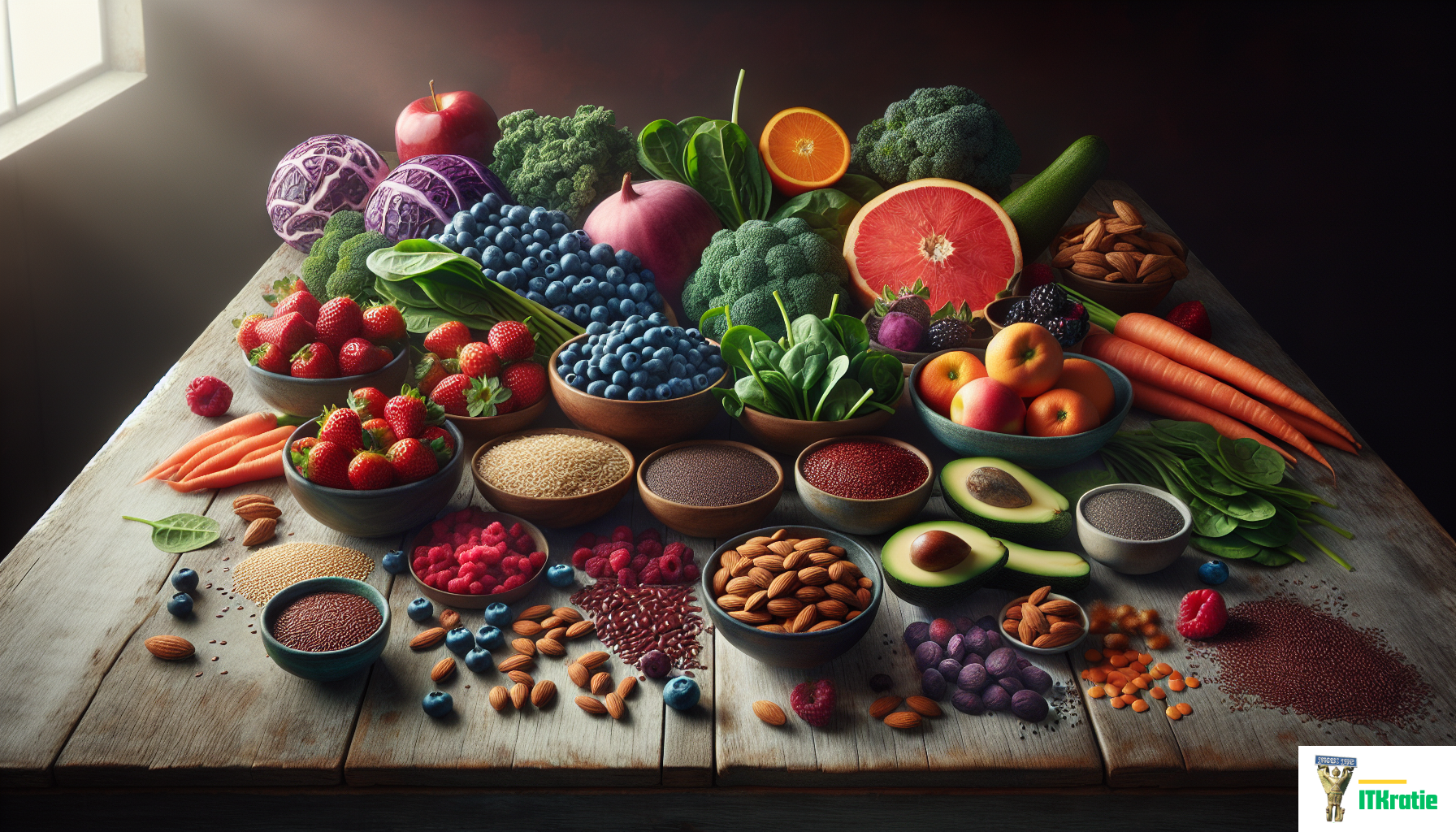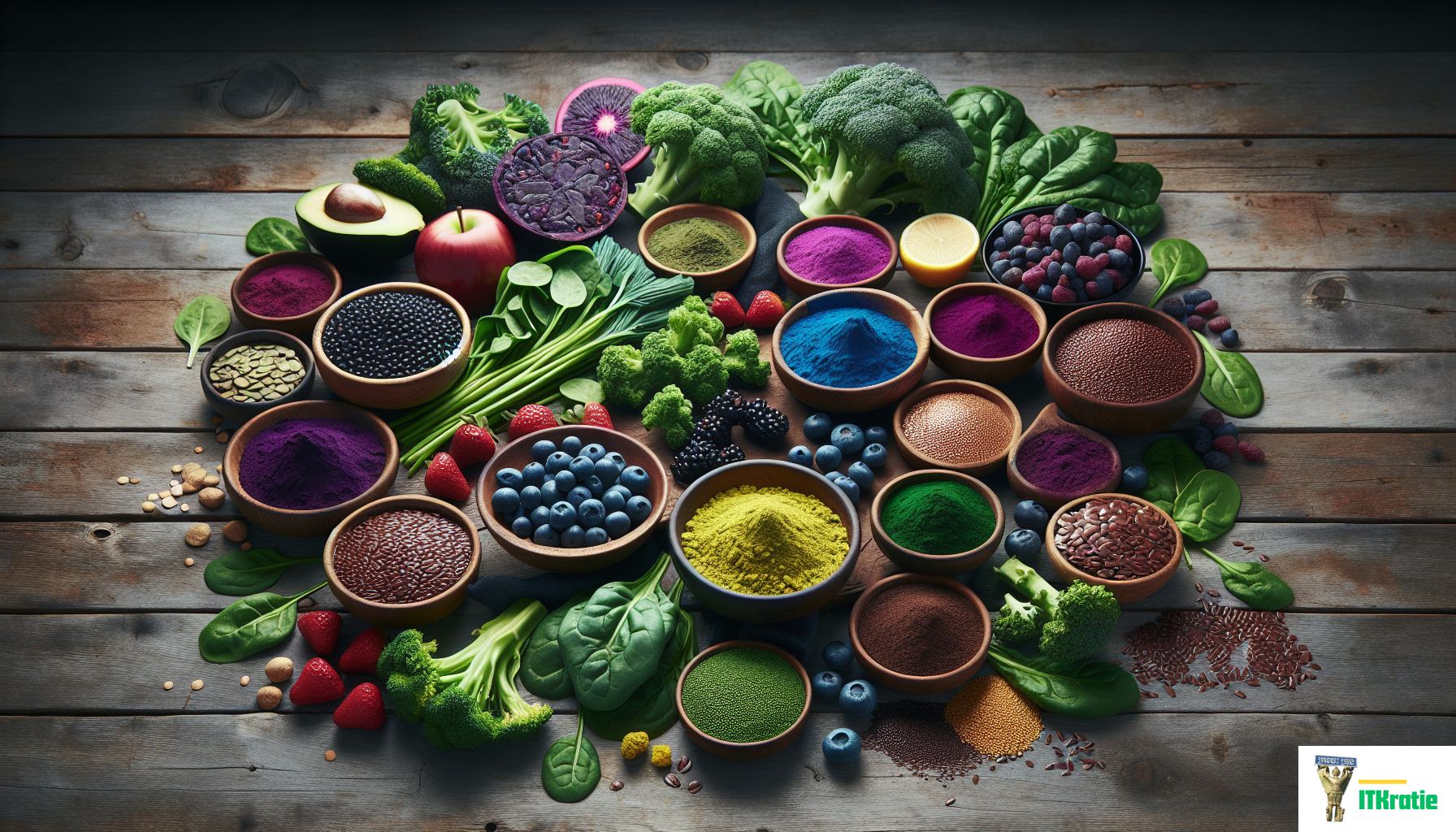Are you looking to boost your overall health and incorporate nutritious foods into your diet? Look no further! In this article, we will explore the top 10 superfoods that are known for their exceptional health benefits. From leafy greens to antioxidant-rich fruits, these nutrient-dense foods will not only nourish your body but also keep you feeling energetic and vibrant. So, get ready to embark on a journey of discovering the best superfoods that can revolutionize your eating habits and enhance your overall well-being.

Heading 1: Blueberries
Subheading 1: Overview
Blueberries are small, round fruits that are known for their vibrant blue color and deliciously sweet taste. They are considered one of the top superfoods due to their numerous health benefits and high nutritional value. Blueberries are native to North America, and they have been enjoyed for centuries by Indigenous peoples and early settlers.
Subheading 2: Health Benefits
Blueberries are packed with antioxidants, which help to protect the body against harmful free radicals. These antioxidants are known to have anti-inflammatory properties, which can help reduce the risk of chronic diseases such as heart disease and diabetes. Blueberries are also rich in fiber, which aids in digestion and promotes a healthy gut. Additionally, blueberries are believed to improve brain function and memory, making them a great food for cognitive health.
Subheading 3: Nutritional Value
Blueberries are low in calories but high in nutrients. They are an excellent source of vitamins C and K, as well as manganese. Blueberries are also rich in antioxidants, such as anthocyanins, which give them their vibrant color. These antioxidants have been linked to a reduced risk of cancer and other age-related diseases.
Subheading 4: Serving Suggestions
There are numerous ways to enjoy blueberries. They can be eaten fresh as a snack, added to smoothies, or used as a topping for yogurt or oatmeal. Blueberries also make a delicious addition to salads and can be used in baked goods like muffins and pies.
Heading 2: Spinach
Subheading 1: Overview
Spinach is a leafy green vegetable that is known for its nutritional density and versatility in cooking. It is often hailed as a superfood due to its impressive health benefits and wide range of nutrients. Spinach has been consumed for centuries and is believed to have originated in Persia.
Subheading 2: Health Benefits
Spinach is rich in vitamins and minerals, including vitamins A, C, E, and K, as well as folate and iron. These nutrients contribute to overall health and can help prevent deficiencies and certain diseases. Spinach is also a good source of antioxidants, which have been shown to reduce the risk of chronic diseases such as cancer and heart disease. Additionally, spinach is high in dietary fiber, which aids in digestion and promotes satiety.
Subheading 3: Nutritional Value
Spinach is a nutritional powerhouse. It is low in calories but high in essential nutrients. One cup of cooked spinach provides around 20% of the recommended daily intake of vitamin A and 40% of the recommended daily intake of vitamin C. Spinach is also an excellent source of iron, which is important for oxygen transport in the body.
Subheading 4: Serving Suggestions
Spinach can be enjoyed in a variety of ways. It can be eaten raw in salads, sautéed with garlic and olive oil, or added to soups and stews. Spinach is also a popular ingredient in smoothies and can be used as a base for green juices. Its mild flavor makes it a versatile ingredient that can be incorporated into many dishes.
Heading 3: Salmon
Subheading 1: Overview
Salmon is a fatty fish that is highly regarded for its delicious taste and numerous health benefits. It is an excellent source of omega-3 fatty acids, which are essential for brain function and heart health. Salmon is native to the North Atlantic and Pacific oceans and has been a staple food in many cultures for centuries.
Subheading 2: Health Benefits
Salmon is packed with nutrients that are beneficial for overall health. It is rich in omega-3 fatty acids, which have been linked to a reduced risk of heart disease and stroke. The omega-3 fatty acids in salmon are also believed to have anti-inflammatory properties and can help alleviate symptoms of conditions such as rheumatoid arthritis. Additionally, salmon is an excellent source of high-quality protein, which is important for muscle growth and repair.
Subheading 3: Nutritional Value
Salmon is a nutritional powerhouse. It is an excellent source of protein, vitamins, and minerals. It is particularly rich in vitamin D, vitamin B12, and selenium. Salmon is also one of the best dietary sources of omega-3 fatty acids, which are essential for brain function and overall health.
Subheading 4: Serving Suggestions
There are countless ways to enjoy salmon. It can be grilled, baked, or roasted with a variety of seasonings and flavors. Salmon can also be smoked or used as an ingredient in dishes such as sushi or seafood pasta. It pairs well with a wide range of vegetables and grains, making it a versatile and delicious protein option.
Heading 4: Quinoa
Subheading 1: Overview
Quinoa is a nutrient-rich grain that originated in the Andean region of South America. It has been cultivated for thousands of years and was considered a sacred food by the Incas. Quinoa has gained popularity in recent years due to its high protein content and numerous health benefits.
Subheading 2: Health Benefits
Quinoa is highly nutritious and is considered a complete protein, meaning it contains all essential amino acids. It is also a good source of dietary fiber, which aids in digestion and helps maintain a healthy weight. Quinoa is naturally gluten-free and is a great alternative for individuals with gluten sensitivities or celiac disease. Additionally, quinoa is rich in vitamins and minerals, including magnesium, iron, and phosphorus.
Subheading 3: Nutritional Value
Quinoa is incredibly nutritious. It is a good source of carbohydrates, protein, and dietary fiber. It is also rich in vitamins and minerals, including folate, magnesium, and phosphorus. Quinoa is particularly notable for its high protein content, as it contains all essential amino acids.
Subheading 4: Serving Suggestions
Quinoa can be cooked and used as a base for a variety of dishes. It can be enjoyed as a side dish, mixed with vegetables and herbs, or used as a filling in stuffed peppers or wraps. Quinoa can also be added to salads, soups, and stir-fries for an extra nutritional boost. Its mild flavor and versatile texture make it a popular choice for incorporating into different cuisines.

Heading 5: Kale
Subheading 1: Overview
Kale is a leafy green vegetable that belongs to the cabbage family. It is known for its dark, leafy greens and slightly bitter taste. Kale has gained popularity in recent years due to its impressive nutritional profile and numerous health benefits. It is believed to have originated in the Mediterranean region and has been cultivated for thousands of years.
Subheading 2: Health Benefits
Kale is packed with nutrients that promote overall health and well-being. It is rich in vitamins A, C, and K, as well as antioxidants. These nutrients contribute to immune function, bone health, and skin health. Kale is also high in dietary fiber, which aids in digestion and promotes satiety. Additionally, kale contains compounds known as glucosinolates, which have been shown to have anti-cancer properties.
Subheading 3: Nutritional Value
Kale is incredibly nutrient-dense. It is low in calories but high in essential vitamins and minerals. One cup of raw kale provides more than 100% of the recommended daily intake of vitamin K and vitamin C. Kale is also a good source of calcium, iron, and potassium.
Subheading 4: Serving Suggestions
Kale can be enjoyed in a variety of ways. It can be used as a base for salads, sautéed with garlic and olive oil, or added to soups and stews. Alternatively, kale can be baked into crispy kale chips or blended into smoothies for an extra nutritional boost. Its versatility and hearty texture make it a popular choice for incorporating into various dishes.
Heading 6: Avocado
Subheading 1: Overview
Avocado is a fruit that is native to Central and South America. It is known for its creamy texture and rich flavor. Avocado has gained popularity in recent years due to its high content of healthy fats and various health benefits. Avocado trees have been cultivated for thousands of years and are believed to have been first domesticated in Mexico.
Subheading 2: Health Benefits
Avocado is packed with healthy monounsaturated fats, which are beneficial for heart health and may help reduce bad cholesterol levels. These fats also contribute to satiety and can aid in weight management. Avocado is also a good source of dietary fiber, which aids in digestion and promotes a healthy gut. Additionally, avocados are rich in vitamins and minerals, including vitamins K, E, C, and B6, as well as potassium.
Subheading 3: Nutritional Value
Avocado is highly nutritious. It is an excellent source of healthy fats and dietary fiber. Avocados are rich in vitamins and minerals, including vitamin K, vitamin E, and potassium. They also contain antioxidants, such as lutein and zeaxanthin, which are important for eye health.
Subheading 4: Serving Suggestions
Avocado can be enjoyed in a variety of ways. It can be sliced and added to sandwiches, salads, or wraps. Avocado can also be mashed and used as a spread on toast or as a base for guacamole. Additionally, avocados can be blended into smoothies or used as a substitute for butter or oil in baking recipes. Its creamy texture and mild flavor make it a versatile ingredient in both savory and sweet dishes.
Heading 7: Chia Seeds
Subheading 1: Overview
Chia seeds are small, oval seeds that are native to Central and South America. They have been consumed for thousands of years and were once a staple food for the Aztecs and Mayans. Chia seeds have gained popularity in recent years due to their high nutritional value and numerous health benefits.
Subheading 2: Health Benefits
Chia seeds are a nutritional powerhouse. They are rich in dietary fiber, which aids in digestion and promotes a healthy gut. Chia seeds are also a good source of plant-based protein, making them a great option for vegetarians and vegans. Additionally, chia seeds are packed with omega-3 fatty acids, which are important for brain function and heart health. These little seeds also contain antioxidants, which help protect the body against free radicals.
Subheading 3: Nutritional Value
Chia seeds are incredibly nutrient-dense. They are low in calories but high in essential nutrients. Chia seeds are an excellent source of dietary fiber, protein, and healthy fats. They are also rich in vitamins and minerals, including calcium, magnesium, and phosphorus.
Subheading 4: Serving Suggestions
Chia seeds can be enjoyed in many ways. They can be sprinkled on top of yogurt or oatmeal for added texture and nutrition. Chia seeds can also be added to smoothies or used as an egg substitute in baking recipes. Additionally, chia seeds can be mixed with water or other liquids to create a gel-like substance, which can be used as a healthy thickening agent in recipes. Their mild flavor and versatile texture make them a popular choice for incorporating into various dishes.
Heading 8: Greek Yogurt
Subheading 1: Overview
Greek yogurt is a type of yogurt that has been strained to remove most of the liquid whey. This process gives Greek yogurt its thick and creamy texture. It is a staple in Mediterranean cuisine and has gained popularity worldwide in recent years due to its high protein content and numerous health benefits.
Subheading 2: Health Benefits
Greek yogurt is an excellent source of high-quality protein, which is essential for muscle growth and repair. It is also rich in probiotics, which are beneficial bacteria that promote a healthy gut and support digestion. Greek yogurt is low in carbohydrates and sugar, making it a suitable option for individuals following low-carb or low-sugar diets. Additionally, Greek yogurt is a good source of calcium, which is important for bone health.
Subheading 3: Nutritional Value
Greek yogurt is highly nutritious. It is a good source of protein, calcium, and essential vitamins and minerals. It is also low in calories compared to other dairy products. Greek yogurt contains probiotics, which promote a healthy gut and improve digestion. It is considered a nutrient-dense food that can contribute to a balanced and healthy diet.
Subheading 4: Serving Suggestions
Greek yogurt can be enjoyed in a variety of ways. It can be eaten plain, topped with fresh fruit or honey for added sweetness. Greek yogurt can also be used as a base for smoothies or as a substitute for sour cream in recipes. It can be added to sauces, dressings, and marinades to enhance flavor and provide a creamy texture. Greek yogurt is versatile and can be incorporated into both sweet and savory dishes.
Heading 9: Almonds
Subheading 1: Overview
Almonds are edible seeds that are native to the Middle East and South Asia. They have been cultivated for thousands of years and are one of the most widely consumed nuts worldwide. Almonds are known for their crunchy texture and slightly sweet taste. They are a popular snack and ingredient in various cuisines.
Subheading 2: Health Benefits
Almonds are packed with nutrients that promote overall health and well-being. They are an excellent source of healthy fats, including monounsaturated fats and polyunsaturated fats, which are beneficial for heart health and may help reduce bad cholesterol levels. Almonds are also high in dietary fiber, which aids in digestion and helps maintain a healthy weight. Additionally, almonds are rich in vitamins and minerals, including vitamin E, magnesium, and calcium.
Subheading 3: Nutritional Value
Almonds are incredibly nutritious. They are low in carbohydrates but high in essential nutrients. Almonds are an excellent source of healthy fats, protein, and dietary fiber. They are also rich in vitamins and minerals, including vitamin E, magnesium, and calcium. Additionally, almonds are one of the best plant-based sources of protein.
Subheading 4: Serving Suggestions
Almonds can be enjoyed in many ways. They can be eaten as a snack on their own or used as a topping for salads, yogurt, or oatmeal. Almonds can also be blended into smoothies or used as a base for homemade almond milk. Additionally, almonds can be roasted and seasoned with various spices for a flavorful snack. Their versatility and crunch make them a satisfying and nutritious addition to any diet.
Heading 10: Sweet Potatoes
Subheading 1: Overview
Sweet potatoes are root vegetables that are known for their vibrant orange color and sweet taste. They are native to Central America and have been cultivated for thousands of years. Sweet potatoes are a staple food in many countries and are enjoyed in a variety of dishes.
Subheading 2: Health Benefits
Sweet potatoes are packed with nutrients that promote overall health and well-being. They are an excellent source of complex carbohydrates, which provide sustained energy and help regulate blood sugar levels. Sweet potatoes are also high in dietary fiber, which aids in digestion and promotes a healthy gut. Additionally, sweet potatoes are rich in vitamins and minerals, including vitamin A, vitamin C, and potassium.
Subheading 3: Nutritional Value
Sweet potatoes are highly nutritious. They are low in calories but high in essential nutrients. Sweet potatoes are an excellent source of complex carbohydrates, dietary fiber, and vitamins A and C. They are also rich in potassium, which is important for heart health and muscle function.
Subheading 4: Serving Suggestions
Sweet potatoes can be enjoyed in a variety of ways. They can be baked or roasted and served as a side dish or main course. Sweet potatoes can also be steamed, mashed, or blended into soups and stews. Additionally, sweet potatoes can be used in both sweet and savory dishes, such as pies, pancakes, and casseroles. Their sweet and earthy flavor makes them a versatile and delicious ingredient.
